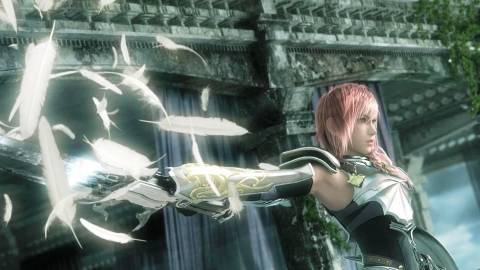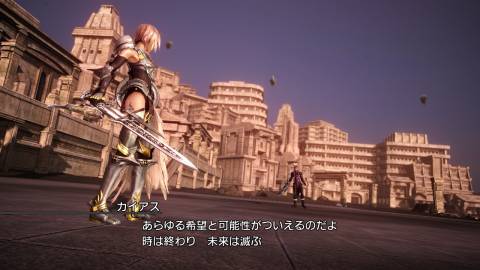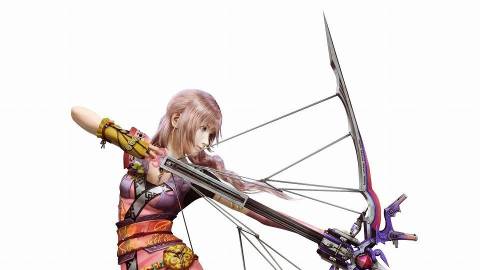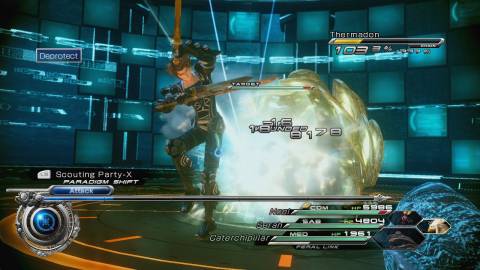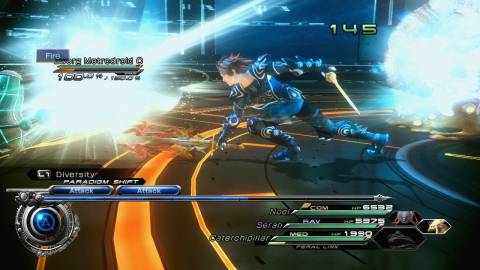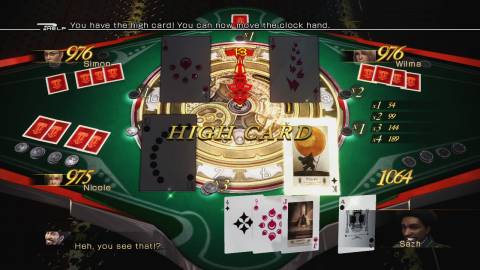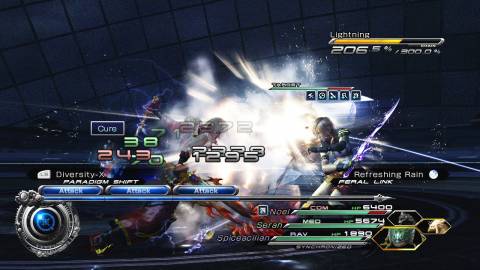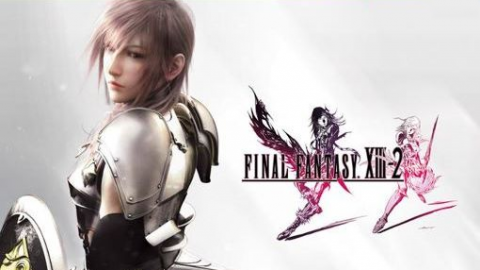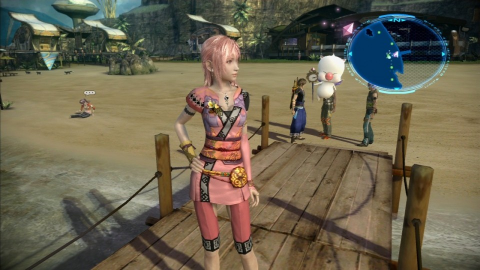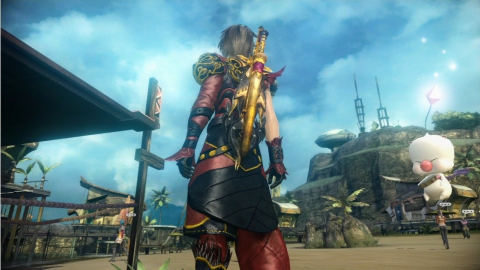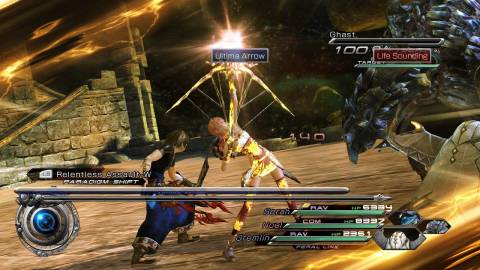Overview
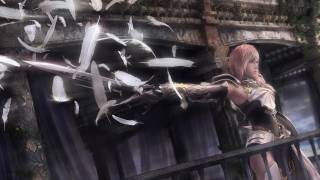
Final Fantasy XIII-2 was created by the same team at Square Enix that made Final Fantasy XIII, including game director Motomu Toriyama. Toriyama also directed the only other direct sequel to a numbered Final Fantasy game in Final Fantasy X-2. Square Enix has said that Final Fantasy XIII-2 would be their answer to the mixed response Final Fantasy XIII received. Final Fantasy XIII-2 was released in Japan on December 15, 2011 and in the U.S. on January 31, 2012.
Gameplay
Combat
The combat in Final Fantasy XIII-2 is based off of the same Active Time Battle system used by its predecessor with some additions. Boss battles now feature periodic quick-time events referred to as "cinematic actions." Successful completion of these events can yield more damage to the enemy and in some cases put them in a staggered state.
The party also has the ability to capture monsters and use them in their party. Monsters take up the third slot in the active battle party roster, and up to three different monsters can be assigned to different paradigms. When the player performs a paradigm shift, the active monster is automatically switched out with the monster assigned to the new paradigm. Each monster has its own special feral abilities; these abilities can be unleashed when a special gauge is filled. The strength of the feral strike depends on the player's performance in a cinematic action.
Additionally, NPC fighters will follow the party and assist in combat, but are not active members of the party roster and cannot be directed in any fashion.
World Design
Dungeons in the game are far less linear than they were in Final Fantasy XIII and contain branching pathways and optional objectives. Some sections of dungeons are also inaccessible the first time that the player comes across them, but can optionally be returned to later in the game. Additionally, Final Fantasy XIII-2 features properly explorable towns. Once the ability to travel through time in the Historia Crux is opened up, the player can freely use it to travel to previously visited periods and locations. As the story progresses, the player will also visit altered versions of previously explored time periods that coexist alongside the original timeline, and the player can travel back and forth between two different versions of the same era.
Paradoxes
Much of Final Fantasy XIII-2 revolves around the aspect of travelling through time, and hence the player will encounter paradoxes - anomalies in the spacetime continuum. This manifests in that monsters and people disappear from their original timelines and gets placed in another. Lightning is for instance one of them. Solving paradoxes are a big part of the game, and there are several types of them.
Temporal rifts are accessed by hurricane-like sand storms that are collections of mini-puzzles.
Paradox endings are alternate endings ot the game that requires closing and re-opening gates and following through the story, but contradicting the main story by causing paradoxes. For instance, fighting monsters before resolving their paradoxes or choosing a different dialogue option than what happened in the main timeline will cause a timeline paradox and hence causing a paradox ending. There are 8 regular endings and one special paradox ending in the game.
Parados quests are often presented to the player via either NPCs, forced dialogue or through object investigation. They require the player to investigate and resolve things like weird connections to a different era or monsters spawning.
Fragments
Fragments in Final Fantasy XIII-2 are bits of information that are gained by winning certain battles, resolving paradoxes, progressing through the story and finding hidden secrets. The game features a total of 160 fragments, and gathering them all is quite time consuming. For instance, one fragment will only be obtainable after you've fought every creature in the game (this includes rare and secrets ones). Only after getting them all is the player able to see the 9th and final Paradox ending.
Chocobos
A new addition to Final Fantasy XIII-2 taken from previous Final Fantasy titles is the ability to ride chocobos. Players that come across a chocobo can feed it gysahl greens in return for being allowed to ride it. Enemies cannot be encountered while riding chocobos.
NPC Interaction
Final Fantasy XIII-2 offers a greater NPC interaction than its predecessor. Numerous NPCs in populated areas can be conversed with, and some will offer the chance to participate in side-quests. The player will also occasionally be asked to choose either Serah or Noel's responses to dialogue at key points that affects how the conversation plays out.
The Crystarium
The Crystarium returns from Final Fantasy XIII in a heavily modified format. Rather than featuring separate tracks for each paradigm role, the Crystarium extends along a single path. However, at each node, the player is given the opportunity to select which role they wish to level up, making character progression more non-linear than it was in the previous game. As the characters reach the end of the path, a new branch opens up to extend it, and the player is given the option of a bonus perk to give the character, such as a new battle role or an additional slot in the ATB gauge.
Saving
Final Fantasy XIII-2 automatically saves the player's progress at certain points. Unlike Final Fantasy XIII, there are no actual save points. Instead, the player is given the opportunity to save the game manually at any point, with the exception of certain areas of the game.
Story
Final Fantasy XIII-2 begins three years after the end of Final Fantasy XIII and focuses on Lightning's sister Serah as well as a new character named Noel Kreiss. It is revealed that Lightning was taken away to Valhalla and now serves a goddess named Etro. However, when she was taken away, the timeline shifted, and most everyone now believes that Lightning is inside the crystal pillar that holds Cocoon aloft over Pulse. Only Serah remembers the timeline as it originally was.
Lightning sends Noel to find Serah and bring her to her. He travels through a time gate to the year 3 AF, where he finds Serah in the midst of a battle against monsters. After learning that Noel has met Lightning and knows where she is, Serah chooses to accompany him on a journey through time.
Change in Direction
Final Fantasy XIII-2 was developed in response to criticism levied at the original game's story, which left a great deal of pertinent information in the in-game encyclopedia, if it was explained at all. The game was also designed to correct elements of gameplay that were also heavily criticized, such as overly linear dungeon design. As such, the game was not meant to originally be part of Square Enix's Fabula Nova Crystallis that would comprise of separate games within the Final Fantasy XIII universe.
At around the same time that Final Fantasy XIII-2 was announced, it was also revealed that Final Fantasy Agito XIII, a PSP title meant to be a part of the franchise, had changed dramatically during development and would no longer be a part of Fabula Nova Crystallis, nor share any connection to Final Fantasy XIII. The game has been renamed Final Fantasy Type-0 and is considered the potential start of a new franchise.
Final Fantasy XIII-2 producer Yoshinori Kitase and game director Toriyama have stated that the development team took criticism from outside the company and overseas to heart, and worked to improve the characters, story and interface. They also promised a greater sense of mystery that players will experience throughout the story in addition to an evolved battle system. Final Fantasy XIII-2 marks one of Square Enix's first forays into focus testing; feedback on earlier titles wasn't collected until after completion, and anything learned wouldn't be implemented until the following game at the earliest. Square Enix took to the idea of focus testing Final Fantasy XIII-2 as one of the concepts borrowed from its acquisition of Eidos.
Reception
Final Fantasy XIII-2 received a cooler reception than Final Fantasy XIII both critically and saleswise. The game's Metacritic score, while still positive at 79, came in at a lower average than the original Final Fantasy XIII's metascore of 83. Final Fantasy XIII-2 also sold 500,000 copies in the first week of release which, while not a failure, pales in comparison to the 1.5 million copies of Final Fantasy XIII that sold during its launch week.
PC System Requirements
Minimum
- OS: Windows® XP SP2 or later
- Processor: 2GHz Dual Core CPU
- Memory: 1500 MB RAM
- Graphics: NVIDIA® Geforce® 8 Series/ ATI Radeon™ HD 4000 series VRAM 256MB or later
- DirectX: Version 9.0c
- Hard Drive: 30 GB available space
- Sound Card: Sound card compatible with DirectX® 9.0c
- Additional Notes:
- *Please be aware that save data processing may take longer than usual while SteamCloud is active, due to synchronisation with the server.
Recommended
- OS: Windows® Vista/ 7/ 8
- Processor: Intel® Core™ 2 Quad (2.66 GHz)/ AMD Phenom™ II X4 (2.8 GHz) processor
- Memory: 2 GB RAM
- Graphics: NVIDIA® Geforce® GTX™ 460/ ATI Radeon™ HD 5870
- DirectX: Version 11
- Hard Drive: 30 GB available space
- Sound Card: DirectX 11 compatible sound card
- Additional Notes:
- *Maximum supported frame rate: 60fps
- *A game controller using Xinput is recomended for this game. (If using a DirectInput based controller, please use the driver side key configuration to adjust settings as required )

 Xbox 360
Xbox 360 PlayStation 3
PlayStation 3 Xbox 360 Games Store
Xbox 360 Games Store.png) PlayStation Network (PS3)
PlayStation Network (PS3) PC
PC Xbox One
Xbox One